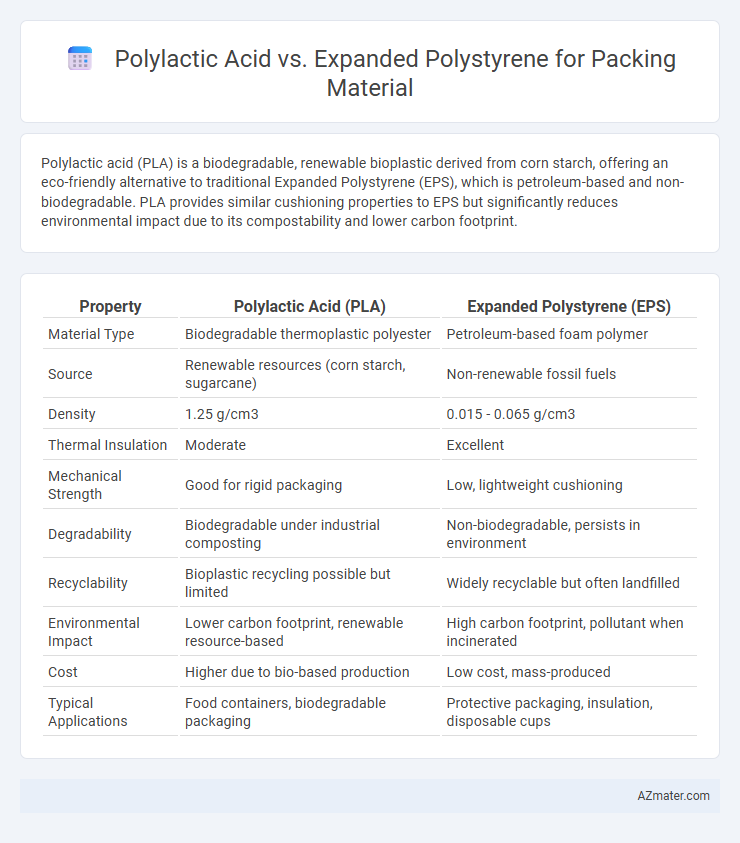Polylactic acid (PLA) is a biodegradable, renewable bioplastic derived from corn starch, offering an eco-friendly alternative to traditional Expanded Polystyrene (EPS), which is petroleum-based and non-biodegradable. PLA provides similar cushioning properties to EPS but significantly reduces environmental impact due to its compostability and lower carbon footprint.
Table of Comparison
| Property | Polylactic Acid (PLA) | Expanded Polystyrene (EPS) |
|---|---|---|
| Material Type | Biodegradable thermoplastic polyester | Petroleum-based foam polymer |
| Source | Renewable resources (corn starch, sugarcane) | Non-renewable fossil fuels |
| Density | 1.25 g/cm3 | 0.015 - 0.065 g/cm3 |
| Thermal Insulation | Moderate | Excellent |
| Mechanical Strength | Good for rigid packaging | Low, lightweight cushioning |
| Degradability | Biodegradable under industrial composting | Non-biodegradable, persists in environment |
| Recyclability | Bioplastic recycling possible but limited | Widely recyclable but often landfilled |
| Environmental Impact | Lower carbon footprint, renewable resource-based | High carbon footprint, pollutant when incinerated |
| Cost | Higher due to bio-based production | Low cost, mass-produced |
| Typical Applications | Food containers, biodegradable packaging | Protective packaging, insulation, disposable cups |
Introduction to Sustainable Packing Materials
Polylactic acid (PLA) and expanded polystyrene (EPS) represent contrasting choices in sustainable packing materials, with PLA derived from renewable resources like corn starch offering biodegradability and reduced environmental impact. Expanded polystyrene, commonly used for its excellent cushioning properties and low cost, poses significant challenges due to its non-biodegradable nature and persistence in landfills. The shift towards PLA highlights increasing demand for eco-friendly packaging solutions that minimize plastic pollution and support circular economy principles.
Overview of Polylactic Acid (PLA)
Polylactic Acid (PLA) is a biodegradable thermoplastic derived from renewable resources such as corn starch or sugarcane, making it an eco-friendly alternative to traditional plastics. PLA exhibits excellent clarity, rigidity, and compostability under industrial conditions, which suits it well for packaging applications requiring sustainability. Compared to Expanded Polystyrene (EPS), PLA offers lower environmental impact through reduced carbon footprint and enhanced biodegradability, making it a preferred choice for eco-conscious packing materials.
Overview of Expanded Polystyrene (EPS)
Expanded Polystyrene (EPS) is a lightweight, rigid foam material widely used for packaging due to its excellent cushioning properties and thermal insulation. EPS consists of 98% air, providing superior shock absorption and protection for fragile goods during transportation. Its cost-effectiveness and ease of molding into custom shapes make EPS a popular choice in industries such as electronics, food packaging, and appliances.
Environmental Impact: PLA vs. EPS
Polylactic acid (PLA), a biodegradable and compostable bioplastic derived from renewable resources like corn starch, significantly reduces environmental pollution compared to Expanded Polystyrene (EPS), which is a petroleum-based, non-biodegradable foam contributing to long-lasting landfill waste and marine pollution. Unlike EPS, PLA decomposes under industrial composting conditions within a few months, minimizing persistent environmental damage and lowering greenhouse gas emissions throughout its lifecycle. However, PLA's effective biodegradation relies on proper industrial composting facilities, while EPS recycling is limited and often economically unfeasible, making PLA a more sustainable choice for eco-conscious packing material solutions.
Biodegradability and Compostability Comparison
Polylactic acid (PLA) offers superior biodegradability and compostability compared to expanded polystyrene (EPS), as PLA decomposes into natural components within industrial composting facilities under controlled heat and humidity. Expanded polystyrene is persistent in the environment, taking hundreds of years to break down, and is not biodegradable or compostable, contributing significantly to plastic pollution. PLA's renewable plant-based origin further enhances its environmental benefits, making it a more sustainable option for packing materials than EPS.
Mechanical Properties: Strength and Durability
Polylactic acid (PLA) demonstrates superior tensile strength and impact resistance compared to expanded polystyrene (EPS), making it more durable under mechanical stress. PLA's biodegradability does not compromise its mechanical stability, maintaining performance in packaging applications requiring cushioning and protection. EPS, while lightweight and flexible, tends to be more brittle and less resistant to deformation over prolonged use.
Cost Analysis: PLA vs. EPS
Polylactic acid (PLA) generally incurs higher initial costs compared to expanded polystyrene (EPS) due to its biodegradable properties and renewable raw materials derived from cornstarch or sugarcane. EPS remains more cost-effective for large-scale packing needs because of its low production expenses and established recycling infrastructure. However, the total cost of PLA may decrease over time with advancements in bioplastic technology and increasing environmental regulations favoring sustainable materials.
Applications and Suitability for Packaging
Polylactic acid (PLA) is widely used in food packaging and biodegradable containers due to its compostability and safe interaction with consumables, making it suitable for sustainable packaging solutions. Expanded polystyrene (EPS) excels in protecting fragile items and insulating temperature-sensitive products such as electronics and frozen foods owing to its lightweight and shock-absorbing properties. While PLA offers environmental benefits ideal for short-term packaging, EPS remains dominant in applications requiring superior cushioning and moisture resistance.
Regulatory and Market Trends
Polylactic acid (PLA) is gaining traction as a sustainable alternative to expanded polystyrene (EPS) in packaging due to increasing regulatory restrictions on single-use plastics and growing consumer demand for biodegradable materials. Governments worldwide, including the EU and US states like California, are implementing bans and taxes on EPS to reduce environmental pollution, driving market adoption of PLA-based packaging solutions. Market trends indicate a rising investment in bioplastics, with forecasts projecting the PLA market to grow at a CAGR of over 15% through 2030, reflecting its regulatory compliance and eco-friendly appeal.
Future Prospects in Packing Material Innovation
Polylactic acid (PLA) presents a biodegradable and renewable alternative to expanded polystyrene (EPS), which is derived from non-renewable petroleum sources and poses significant environmental challenges due to its persistence in landfills. Innovations in PLA packaging focus on enhancing its mechanical strength, thermal resistance, and compostability, positioning it as a sustainable solution aligned with global regulatory trends aiming to reduce plastic waste. Future prospects include integrating nanomaterials and bio-based additives into PLA formulations to improve performance characteristics, potentially replacing EPS in diverse packaging applications while supporting circular economy objectives.

Infographic: Polylactic acid vs Expanded polystyrene for Packing Material
 azmater.com
azmater.com